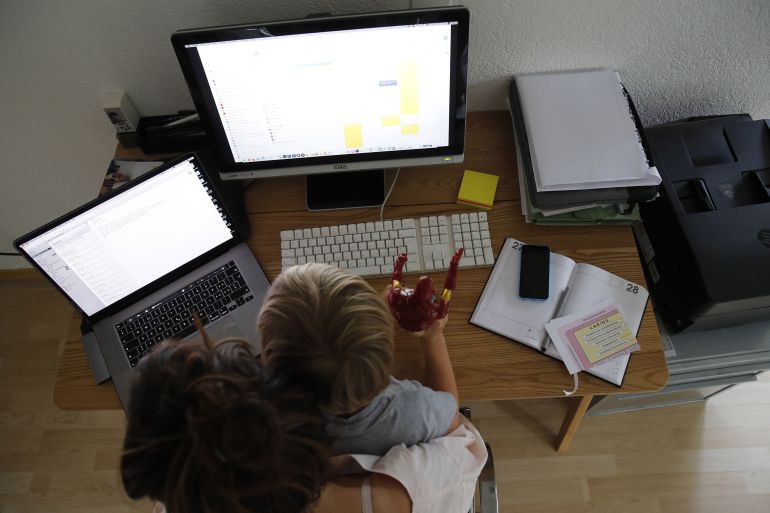Mom burnout: Pandemic driving millions of women from US workforce
The pandemic has exacerbated gender inequities that force mothers into the ‘double shift’ of work and childcare.

For months at the beginning of the coronavirus pandemic, Ashley Austrew tried to make it work.
The mother of two logged on to her marketing job before her kids woke up, juggled homeschooling during the day, signed on again when her husband came home from work and then freelanced into the wee hours of the morning after cooking her kids dinner and putting them to bed. But the Omaha, Nebraska-based writer came to feel like she was failing at everything: There simply were not enough hours in the day to work full-time and parent her six- and eight-year-old children while her husband – an essential worker at a manufacturing company – went to the office.
Keep reading
list of 4 itemsGender penalty: Student debt and daycare stifle American mothers
‘Motherhood penalty’ starts even before kids, study finds
Gender study: To shatter the glass ceiling, fix the ‘broken rung’
“With constant interruptions, multiple schedules to juggle, and everything else, it felt more like I needed to work 60 hours or 80 hours to finish what I used to do in 40,” Austrew, 33, told Al Jazeera. “And that’s not possible when you also need to be a parent 100 percent of the time.”
Austrew felt like she could never close her laptop. Her kids were miserable and struggling for her attention. She barely had any sleep or time with her husband. She hoped the long hours she was putting in would lead the CEO of the company she worked for to convert her from an independent contractor to an employee with benefits. Maybe, she thought, she could hold on a little longer.
“It was really hard, and I kept giving myself mental checkpoints – just get to the end of the school year, just get through the first month of summer et cetera – and then things will be better. But when those checkpoints passed and I started thinking about the future, it became clear that something had to give,” Austrew said. “So it became a question of whether or not my work was truly worth fighting for, and when I was really honest with myself, the answer was no.”
Austrew quit her $55,000-a-year job, stepping into the void as the US economic recovery slows and unemployment hovers near 8 percent.

She is far from alone: Participation of women between the ages of 25 and 54 in the US labour force dropped by more than 5 percent from August to September as many schools remain closed and families are tasked with remote learning, according to Labor Department data.
And while parents of all genders are struggling, the crisis is taking a bigger toll on women, and disproportionately impacting women of colour. Some 865,000 adult women – including 324,000 Latinas and 58,000 African American women – dropped out of the labour force last month – roughly four times the amount of men, according to the US Bureau of Labor Statistics.
The trend may be far from over. As many as two million women are considering leaving the workforce because of the strain of the pandemic, McKinsey and LeanIn.org’s 2020 Women in the Workplace study found, and many report the burdens of caregiving, homeschooling and working are just too tough.
It is a refrain Amanda Kowal Kenyon, an organizational psychologist and executive coach who works with the global public relations firm Ketchum, has heard a lot.
“In my executive coaching work and in talking with other working moms in general, one thing that’s come up as a theme is expectation management: High-performing women are struggling to lower the bar on the expectations they have for themselves, and they’re having a hard time raising the bar on the expectations they have of their organizations or their partners in parenting,” Kowal Kenyon, 46 and the mother of a teenager, told Al Jazeera.
“I remain astounded that in the majority of homes with two working parents – including my own – the mother is the primary parent who shoulders the burden of caregiving and homeschooling,” she added.

‘Second shift’ burden
Worldwide, women do at least two and a half times more unpaid housework and caregiving than men, according to the UN, even if both people work full-time outside of the home. And with schools and childcare centres shuttered because of COVID-19, women have found themselves taking on even more, said Caitlyn Collins, an assistant professor of sociology at Washington University in St Louis and the author of Making Motherhood Work: How Women Manage Careers and Caregiving.
“Even though women work nearly on par with men in the paid labour force today, women also complete what sociologist Arlie Hochschild calls the ‘second shift’ once they return home: women complete two-thirds of the household activities necessary to keep families afloat these days,” Collins told Al Jazeera. “Early evidence from the pandemic suggests that it is women who are picking up the added responsibilities of homeschooling, added chores, and round-the-clock caregiving.”
US working mothers are 1.5 times more likely than working fathers to report spending an extra three or more hours a day on housework and childcare – and that adds up to an extra 20 hours a week, the equivalent of an unpaid part-time job, the McKinsey study found. Single mothers, of course, face even more challenges.
“Women’s disproportionate responsibility for childrearing impedes their ability to work in the paid labour force,” Collins explained. “There are only 24 hours in the day, and the simple truth is that more of women’s time goes to caring for kids than men’s do. This disparity has major consequences over the life course for women’s lifetime earnings potential.”
Gender wage gap and the ‘motherhood penalty’
Women in the US also earn less than men at their paying jobs. Women are paid 82 percent, on average, for the same work as men, according to US Census Bureau data. The gender wage gap is even wider for women of colour and older women, the nonprofit American Association of University Women found, and collectively, working women lose $500m in wages each year.
Unlike previous economic downturns, the coronavirus recession is likely to widen the gender wage gap by 2 percent, according to a study by researchers at Northwestern University published in August. Women’s unemployment rate remains higher than men’s even months into the crisis, and women’s jobs have been slow to come back, partly because women-dominated industries were hit hardest.
Our economy relies on our childhood education and care systems – without them, nothing else works.
Family care is also being discussed on the 2020 campaign trail. Democratic presidential candidate Joe Biden unveiled a $775bn plan to help fix America’s broken child and elder care system over the next 10 years with expanded tax credits, sliding-scale subsidies and greater investment in care workers and facilities.
Working families saw a doubling of the child tax credit to $2,000 during President Donald Trump’s time in office and he has promised to consider bipartisan paid family leave legislation, although that has not happened.
The US remains the only developed country in the world that does not guarantee mothers paid maternity leave.
When women earn less than men, they may be the ones who are forced to step back when families have to make tough choices about childcare. That was the case for Austrew’s family.
“Even though [my husband’s] job has tried to be flexible and helpful during this time, there is still the unspoken expectation that if my husband is ‘essential,’ that means someone has to be taking care of his children,” Austrew said. “My husband and I were close to equal in salary when I was working full-time, but he has much more opportunity for advancement, he carries our health insurance and other important benefits, and his job is simply more secure because he’s not a freelancer or contractor.”
To compensate for the hit in family income, Austrew has picked up more freelance work and the family has scaled back spending. If she were not able to work at all, she said, her husband “couldn’t cover all of our expenses on his own, but he could cover a majority of them”.
But Austrew also worries about the challenges she could face when she looks for full-time work again. Leaving work to care for children – even temporarily – has a negative effect on women’s lifetime earning potential. Workers who take extended periods of time off may struggle to keep their skills sharp – or adapt to new technologies. And employers’ misconceptions about mothers’ competence and commitment to work leads to biases in hiring in what is known as the “motherhood penalty”.
We can’t expect parents to be full-time caregivers and full-time workers for the long term. It is impossible.
Kowal Kenyon advises women to talk to their companies about “creative ways that allow them to remain tethered to the workplace”, even while working fewer hours, and to realign their expectations for themselves.
“I think it’s important to define and clarify what our current career goals are right now and put a time boundary around it – perhaps focusing now just on Q4, or even shrinking that goal to this month,” she said. “And crucially, I think we can normalize the idea that this time can also be used for just survival or maintaining performance – and regroup on the idea of advancement at a later date.”
Of course, women in low-wage jobs might not have the option of flexibility in their working hours or situation, which is one of the ways in which the pandemic has exposed and exacerbated long-standing inequities.
That is why, in the short-term, families need another stimulus cheque while states reopen schools and childcare centres safely, Collins said. But systemic change is also needed.
“Our economy relies on our childhood education and care systems – without them, nothing else works,” she said. “Going forward, it’s time we catch up to every other advanced economy and implement paid family and medical leave, a public pre-K system, fair work schedules, and living wages to support America’s working families. These common-sense policies are long overdue.”
Austrew agrees. “For me, it’s absurd the way Americans have been asked to carry on as normal during a pandemic,” she said. “So many are unemployed or working impossible schedules because they don’t have the option to scale back at work. We can’t expect parents to be full-time caregivers and full-time workers for the long term. It is impossible.”